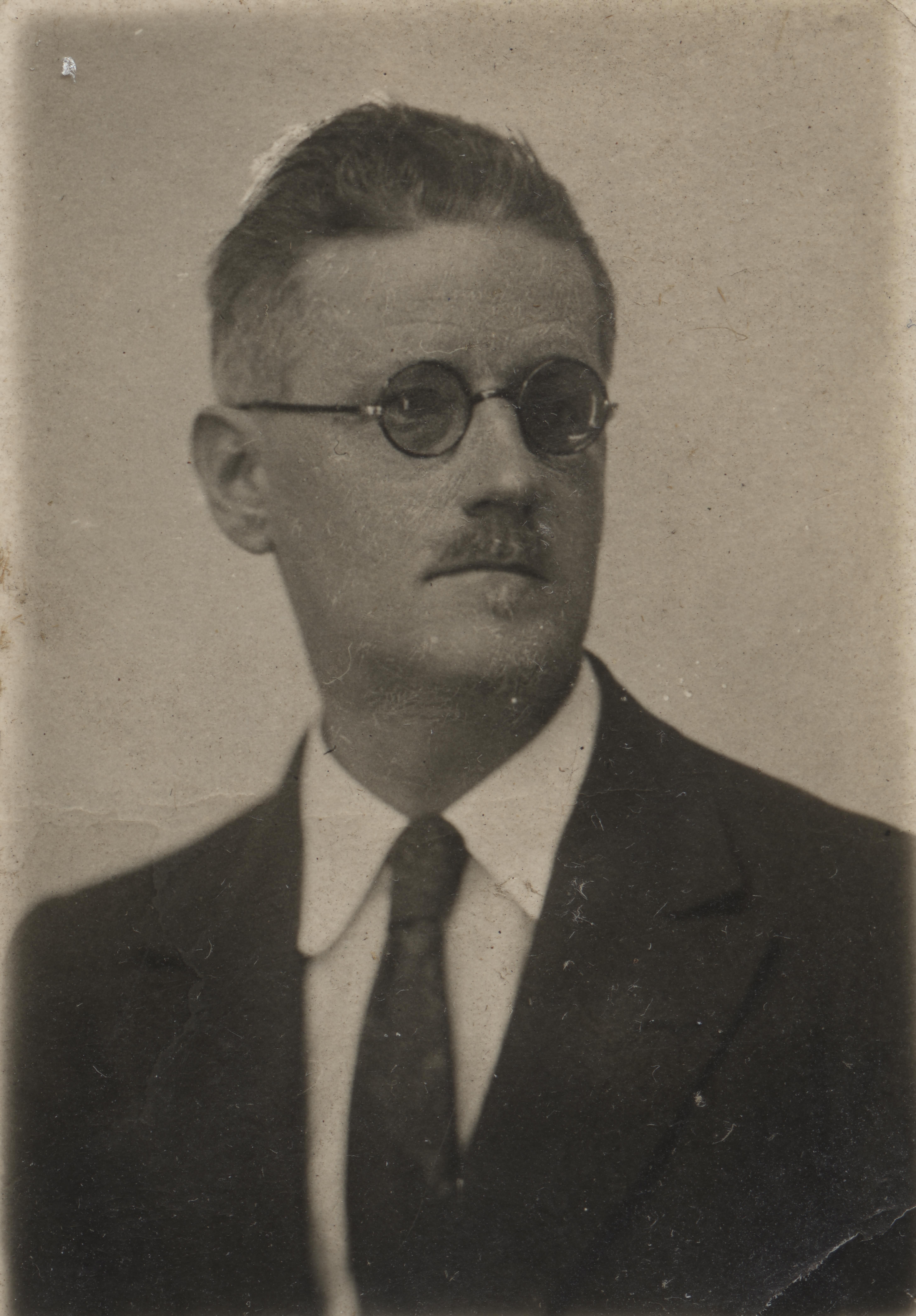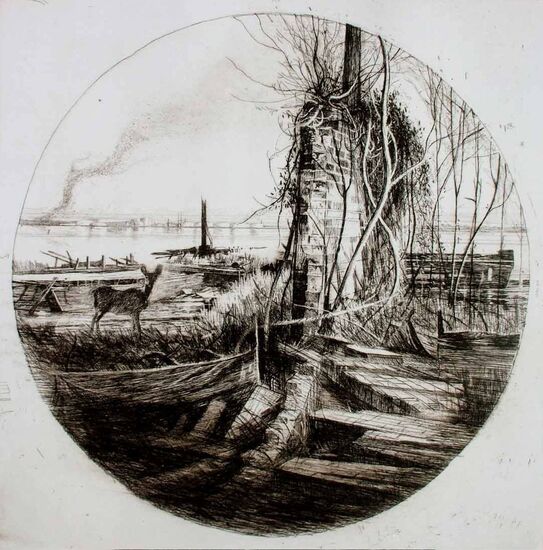The right person, in the right place, at the right time.
That in essence explains how the University at Buffalo came to have the largest James Joyce collection in the world.
The person was UB professor of English Dr. Oscar Silverman. He was on a 1949 sabbatical in Paris when Librairie La Hune, a bookstore and gallery on Boulevard Saint-Germain, featured “Exposition en homage à James Joyce” from Oct. 15 to Dec. 10.
“He saw it a number of times,” said Dr. James Maynard, curator of the UB Poetry Collection, which includes the James Joyce Collection.
Silverman was accompanied on one visit by Lucie Léon, wife of Paul Léon, Joyce’s late friend and secretary. Friends and supporters had put together the show based on family documents and artifacts with a view to supporting the writer’s wife Nora who’d left wartime Paris with him 10 years earlier, before France fell to Nazi Germany. “The idea was at the end of the exhibition they would auction it off,” Maynard said of the event titled, “James Joyce: Sa vie, son oeuvre, son rayonnement,” which also had a stint in London.
Silverman saw the opportunity, and upon his return to the then privately-run University of Buffalo initiated the effort that led to the transfer of the exhibition’s almost 600 items to a permanent American home in 1950. That was just the beginning of UB’s remarkable collection of Joyceana – five more major installments from three sources would be added through the next 18 years, with the most notable being the 1959 acquisition from “Ulysses” publisher, and owner of the Paris bookstore Shakespeare and Company, Sylvia Beach.
“A tour of the Joyce collection is truly a transformative experience,” Maynard said.
Right now, though, it’s recommended that visits are organized in advance of traveling to UB. “We’ve always been limited by our current facilities,” the curator said.
So, in recent times, the Poetry Collection set in motion a process that will see the creation of a UB James Joyce Museum.
“This collection belongs to the people,” Maynard said.

Dr. James Maynard, curator of the UB Poetry Collection, pictured with family portraits from the James Joyce Collection in the background.
The plan has won public support in Buffalo, including in its sizable Irish-American community, and the backing of leaders such as Congressman Tim Kennedy. The State of New York has donated $10 million to UB, which is part of the SUNY system, for the creation of the museum. Official Irish backing has been enthusiastic, with former Ambassador to the U.S. Daniel Mulhall and former Consul General to New York Ciarán Madden speaking on a promotional video for the museum, alongside writers like Colm Tóibín.
In the video, Kelly Hayes McAlonie, director of Campus Planning, said that the museum’s proposed location on the South Campus at Abbott Hall is a “front door” for UB, and so putting it there “will only enhance the university and also the community at large.”
What is now called the Poetry Collection was established in 1935, and thus UB had some practice in negotiation and acquisition. The promise to Nora Joyce that the family’s papers, books, photographs, portraits and other personal effects would be kept safe and not dispersed led to a $5,000 check being sent to Europe and a second for the same amount after their arrival in Buffalo.
The funding came in the form of a gift from Margaretta F. Wickser made in memory of her husband Philip J. Wickser, a Buffalo arts patron, book collector and lawyer who was president of the American Bar Association.
However, Buffalo’s extraordinary collection would never have been possible without the earlier endeavors of another couple, Paul and Lucie Léon. Maynard has written that the novelist’s secretary Paul “twice crossed the streets of occupied Paris with a handyman and a pushcart to rescue materials from Joyce’s apartment [at 34 rue des Vignes], having bribed the concierge, and [he] later bought back additional items when they were auctioned off by the owner of the apartment as reimbursement for unpaid rent.”
On Aug. 21, 1941, Paul Léon was arrested by the Nazis (Joyce had died in Zurich on Jan. 13). He was transferred the following year to Auschwitz, where he was murdered. Lucie Léon, later the guide to UB’s Dr. Silverman at the exhibition, ensured that Joyce’s belongings were kept safe in Paris for the war’s duration.

James Joyce pictured in 1888 at age 6 with his parents and maternal grandfather. [The Poetry Collection of the University Libraries, University at Buffalo, The State University Of New York]
Joyce’s stock had risen by 1959 when an offer of $55,510 was made to his most vital friend in Paris, Sylvia Beach. In June of that year, she traveled to Buffalo to be conferred with an honorary doctorate in recognition of her courage in publishing “Ulysses.” Later that summer, the latest installment for UB’s James Joyce Collection was placed on the “Queen Elizabeth,” and Beach insisted that Dr. Silverman travel with it across the Atlantic rather than fly.
In the same year, New Yorker B.W. Huebsch, publisher of the first edition of “A Portrait of the Artist as a Young Man” and a Joyce associate, donated the second of his significant installments for the UB James Joyce Collection; the first was in 1951. His company, which merged with Viking in 1925, was also the first American publisher of “Dubliners,” “Exiles” and “Chamber Music.”
Another installment followed upon Beach’s death in 1962, with the help of American benefactors.
And finally, again from Paris, in 1968, Maria Jolas, one of the friends who’d put together the Librarie La Hune exhibition, provided the 1927-28 galley proofs of the serialized publication of “Finnegans Wake” as “Work in Progress” in her and her husband Eugene Jolas’s experimental magazine “transitions.” The galley proofs are heavily revised by Joyce.
Maynard has written, “Also included [in the materials from the Paris bookstore owner] is one of the great association copies: copy number 2 of the first edition of ‘Ulysses,’ signed and inscribed by Joyce ‘To Sylvia Beach in token of gratitude James Joyce Paris 13 February 1922,’ bound by Beach in blue Morocco (to approximate the color of the French paper wrappers) along with Joyce’s poem of appreciation and homage, ‘Who is Sylvia,’ written after William Shakespeare’s lines beginning ‘Who is Sylvia’ in ‘The Two Gentlemen of Verona.’”

Syliva Beach and James Joyce pictured in the doorway of her Shakespeare and Company bookstore in Paris. [The Poetry Collection of the University Libraries, University at Buffalo, The State University Of New York]
The Poetry Collection curator’s history at UB goes back to the summer of 2001 when he enrolled to do a PhD in the Poetics Program. Previously, Maynard did a master’s in contemporary poetry at Temple University, and prior to that had taught high-school English for two years. In 2007, he completed his doctoral degree in English, with a specialty in 20th century American poetry, and a particular focus on the works of the poet Robert Duncan.
In his early UB years, he began working in the Poetry Collection and through that its James Joyce Collection. “I fell in love with it as a graduate student and have had the good fortune of continuing to work in it ever since,” said Maynard, who grew up outside of Philadelphia.
He was particularly drawn to Joyce’s life, his writing processes, his role in international modernism and the support network of people around him like Beach.
“It’s fascinating to hear everyone’s story when they come to the collection, whether it’s for research, whether it’s for a community tour, to hear what draws them to Joyce,” he said.
“There are just countless stories of writers and artists and readers who have fallen in love with Joyce, particularly with ‘Ulysses’ and to a lesser degree sometimes ‘Finnegans Wake,’” said Maynard, who was appointed UB Poetry Collection curator in 2016, having previously held other positions at the institution. “They’ve become lifetime books, they’ve become touchstones. Both books reward continual readings throughout one’s life.
“The people who come here are drawn to one of two different facets of the collection,” he said. “On the one hand, people are drawn to the historical artifacts that were part of his life. Whether that be his canes, his passport, his glasses, the things that he owned and used in everyday life. And they do quite a remarkable job of humanizing him, of showing what he was like as a person, as a son, as a brother and as a father.
“But, I think, if I had to choose,” he said, referring to the other facet, “It would be his notebooks, his manuscripts, in particular for ‘Ulysses’ and ‘Finnegans Wake.’ They truly capture his writing process, which for both of those books was extremely complicated and complex.”
Maynard said, “A lot of people come here who are interested in Joyce, but in a purely non-academic way, [and] might not have even read much Joyce. But for whatever reason, oftentimes because of their Irish heritage, they recognize Joyce as a connection to something larger and more significant than themselves, and they want to experience it.”
Larger than everyone is the mural of James Joyce in Downtown Buffalo, created almost as a statement of intent in 2021, something tangible on bricks and mortar, while UB put a plan together that included, in addition to a permanent exhibition space, a guarantee of the James Joyce Collection’s growth through a preservation and acquisitions endowment, a James Joyce curator, and programming and exhibition funds.
In an essay for the 2022 book accompanying the Morgan Library and Museum’s centenary exhibition on “Ulysses” in New York City, Maynard wrote of the university’s ambitious vision, “In this pursuit our aim is nothing less than to invite the entire world to experience the literary life and works of Ireland’s James Joyce while ensuring the continuation of the UB James Joyce Collection as an international destination for research and discovery.”









